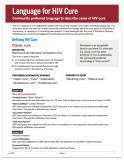- About UsOur Story, Our Team & Support Information
- What We DoAdvocacy to Achieve the End of AIDS
- Advance HIV/SRH Integration
- Advocate for Access to High-Impact Prevention
- Improve Research Conduct
- Product Innovation & Availability
- Promote Effective HIV Prevention Policy
- Strengthen Global Advocacy Networks
- Track and Translate the Field
- Our FocusInterventions to End the Epidemic
- ResourcesPublications, Infographics, Events & More
- MediaInformation & Resources for the Press
- Our BlogPrevention News & Perspective
A cure for HIV infection is one of the ultimate long-term goals of research today. The science is expanding, raising hopes and challenges.
The term “cure” refers to strategies that would eliminate HIV from a person’s body, or permanently control the virus and render it unable to cause disease. A range of strategies being discussed today.
A “sterilizing” cure would completely eliminate the virus.
A “functional” cure would suppress HIV viral load, keeping it below the level of detection without the use of antiretrovirals for treatment (ART). The virus would not be eliminated from the body but would be effectively controlled and prevented from causing any illness.
“Remission” refers to undetectable virus that may or may not return because a low level of latent virus.
Researchers are still trying to define these terms and which strategies will work. Although some possible cases of functional cures have been reported, it takes time to be certain that HIV can no longer cause disease—because even very low levels of virus can increase the risk of illness and ultimately lead to AIDS.
Some cure strategies under investigation are carry potential risks. Communicating the risks and benefits of cure strategies to potential trial participants will be an important part of any cure clinical trial. Interrupting treatment will be an important element in cure trials in order to test viral rebound. No standardized guidelines exist yet for such “treatment interruptions” to minimize risks for cure trial participants. Finally, cure strategies may look different for men, women and children—biological differences between sexes, and differences in adult versus pediatric immune systems mean a “one size fits all” approach to a cure is unlikely. AVAC is working with partners to track, translate and accelerate cure research.
What We're Reading
Featured Resources

